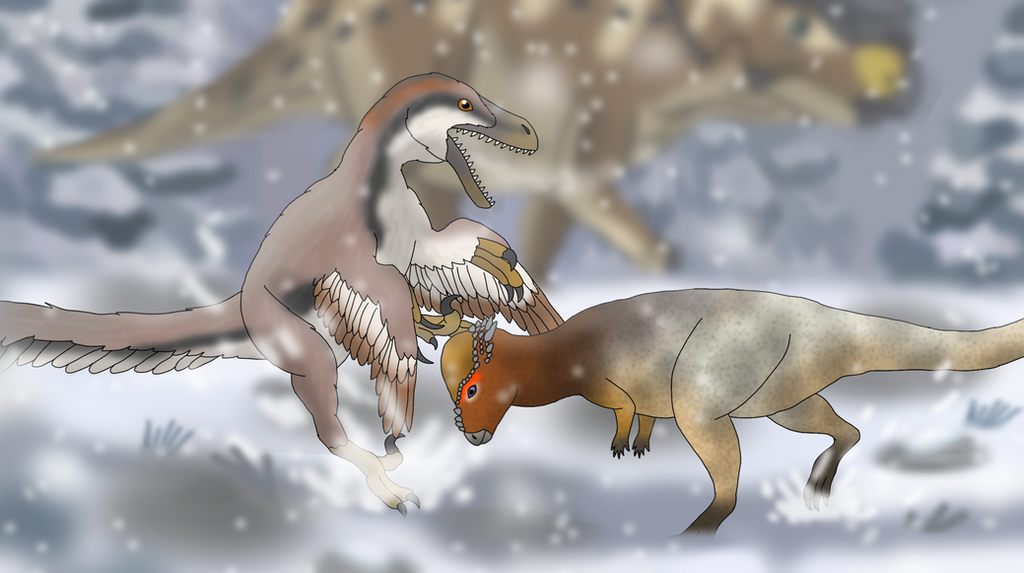HOME | DD
 Olmagon — Duel in the Cold
Olmagon — Duel in the Cold

#alaska #ceratopsian #cretaceous #digitalart #digitaldrawing #digitalillustration #digitalpainting #dinosaur #dromaeosaur #mesozoic #pachycephalosaur #pachycephalosaurus #pachyrhinosaurus #paleoart #paleontology #raptor #snow #snowing #snowwinter #winter #feathereddinosaur #saurornitholestes #paleoillustration #marginocephalia #alaskacephale #saurornitholestinae #polardinosaur
Published: 2021-10-06 19:44:32 +0000 UTC; Views: 22455; Favourites: 223; Downloads: 6
Redirect to original
Description
During a particularly cold winter 70 million years ago in what is now the Prince Creek Formation of Alaska, the temperature dropped so low that water vapour was able to freeze into snow, and a thin layer of snow now covers part of the ground and bits of the conifer trees. In a pine forest, a large, 7-meter ceratopsian dinosaur, Pachyrhinosaurus perotorum, walks past two smaller dinosaurs fighting each other, one trying to make a meal out of the other. The intended prey is a 2-meter long pachycephalosaur dinosaur called Alaskacephale gangloffi, and with a thick, bony skull capable of strong headbutts, it charges with its head down, intending to skullbash its attacker. The predatory dinosaur trying to bring down the Alaskacephale is a dromaeosaur of the Saurornitholestinae subfamily, similar in size to the pachycephalosaur, and is armed with sharp teeth and claws including a retractable innermost claw on each hindlimb. While the saurornitholestine is a dangerous predator, its prey also fights back hard and its headbutts could also injure the gracile feathered dinosaur with frail hollow bones.Drawing made after Slatetheraptor (www.deviantart.com/slatetherap… ) requested that I draw dinosaurs fighting in the snow on my profile comments, and suggested it be in the Prince Creek Formation. Well they didn't say which species it should be and I've drawn Prince Creek fauna before (www.deviantart.com/olmagon/art… ), so I picked the two dinosaurs I didn't add to the previous Prince Creek drawing due to running out of room in that one.
While the world was indeed much warmer in the Mesozoic than it is now, the Prince Creek Formation of Alaska would have still been quite cold during the Cretaceous. The mean temperature was 5 to 6 degrees Celsius, winter temperatures were 2 to 4 degrees Celsius and summer temperatures were 10 to 12 degrees Celsius. While that's quite damn cold, you could notice that even in winter it's usually not cold enough to snow. However I think that some winters could have been particularly colder than usual, and during those it could have snowed (probably still wasn't as common an occurrence as some people think).
Discovered in 1999 and named in 2006, Alaskacephale gangloffi is the first dinosaur to have been found in the Prince Creek Formation, and would go on to yield a wide variety of dinosaurs and become one of the best-known locations for polar dinosaurs. Like most Prince Creek fauna though, it is only known from fragmentary remains, and in this dinosaur's case it is known exclusively from a small part of the skull. It was a member of the Pachycephalosauridae family, commonly called the "dome-headed" or "bone-headed" dinosaurs as most had domes of thick bone on the top of their heads, suggesting they frequently engaged in headbutting for combat. Alaskacephale was a smaller species of pachycephalosaur, growing only around 2 meters long, and like other species in its family it would've been either a herbivore or omnivore that occasionally ate small animals like insects.
Apart from the tyrannosaur Nanuqsaurus and a large unnamed troodontid, the theropods of Prince Creek are very fragmentary and poorly known. Apart from those two, the only remains of theropods from the area were isolated teeth believed to belong to dromaeosaurs (or raptors if you prefer that word) and suggest perhaps two dromaeosaur species lived here, one similar to Dromaeosaurus and one similar to Saurornitholestes. In 2020, one extra remain of a theropod from the area was described, and it was a small fragment of the lower jaw. This jaw piece is thought to be from a dromaeosaur similar to Saurornitholestes, and is placed in the Saurornitholestinae subfamily. The small size of the jaw fragment and fibrous bone surface suggests the animal was a juvenile when it died, and despite being that fragmentary it is still one of the best-preserved theropod remains from Prince Creek (yeah everything here is fragmentary). Between the teeth and the jaw shard, it seems that some species of saurornitholestine dromaeosaur lived in Prince Creek, probably around 2 meters long as an adult, and it would have preyed on the small and medium-sized animals of the habitat.
The Pachyrhinosaurus is a background creature and I'm not going into detail on facts about it since I already wrote some before here if you're interested (www.deviantart.com/olmagon/art… ). Also, while some people may reconstruct Pachyrhinosaurus and/or Alaskacephale with a woolly coat of protofeathers, I am quite uncertain and skeptical about feathers in marginocephalians so the ceratopsian here stays warm with thick blubber and the pachycephalosaur has some blubber and mostly hides in its burrow during winter instead for warmth. Until there's a specimen of a ceratopsian or pachycephalosaur showing better direct evidence of feathers (and I don't mean those bristles on Psittacosaurus) I am a bit reluctant to feather them.
Related content
Comments: 10

👍: 0 ⏩: 1

👍: 1 ⏩: 1

👍: 1 ⏩: 0

👍: 0 ⏩: 1

👍: 1 ⏩: 1

👍: 0 ⏩: 1

👍: 1 ⏩: 0

👍: 0 ⏩: 1

👍: 0 ⏩: 0


























